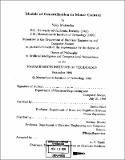Models of generalization in motor control
Author(s)
Matsuoka, Yoky, 1971-
DownloadFull printable version (13.34Mb)
Advisor
Emilio Bizzi and Rodney Brooks.
Terms of use
Metadata
Show full item recordAbstract
Motor learning for humans is based on the capacity of the central nervous system (CNS) to perform computation and build an internal model for a task. This thesis investigates the CNS's ability to generalize a learned motor skill throughout neighboring spatial locations, its ability to divide the spatial generalization with variation of context, and proposes models of how these generalizations might be implemented. The investigation involved human psychophysics and simulations. The experimental paradigm was to study human neuromuscular adaptation to viscous force perturbation. When external perturbations were applied to the hand during a reaching task, the movement became distorted. This distortion motivated the CNS to produce counterbalancing forces, which resulted in the modification of the internal model for the task. Experimental results indicated that the introduction of interfering perturbations near the trained location disturbed the learned skill. In addition, if the same movement was perturbed in two opposite directions in sequence, neither of the forces are learned. Conversely, the adaptation to two opposite forces was possible within the same space when the forces were applied to two contextually distinguished movements. This was possible only when these movements were interleaved fairly regularly. During the adaptation to a difficult task, such as contextual distinction in the same spatial location, humans often used other strategies to avoid learning the actual paradigm. These strategies allowed subjects to perform the task -- without changing their internal models appropriately, and thus this was also investigated as a part of the learning process. Finally, a multiple function model was constructed which allowed multiple contextually dependent functions to co-exist within one state space. The sensory feedback affected all functions, however, only one function was active to output a motor command. This model supported the experimental data presented. The results of the psychophysical experiments as well as an explanation of the simulations and models that were developed will be presented in this thesis.
Description
Thesis (Ph. D.)--Massachusetts Institute of Technology, Dept. of Electrical Engineering and Computer Science, 1998. Includes bibliographical references (p. 207-215).
Date issued
1998Department
Massachusetts Institute of Technology. Department of Electrical Engineering and Computer SciencePublisher
Massachusetts Institute of Technology
Keywords
Electrical Engineering and Computer Science